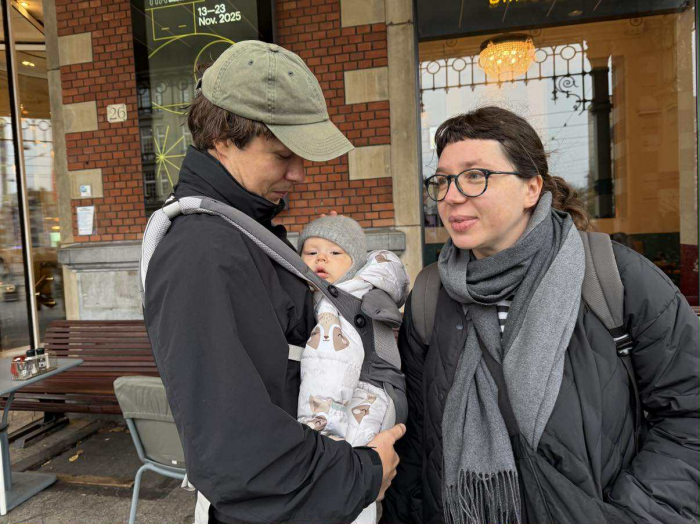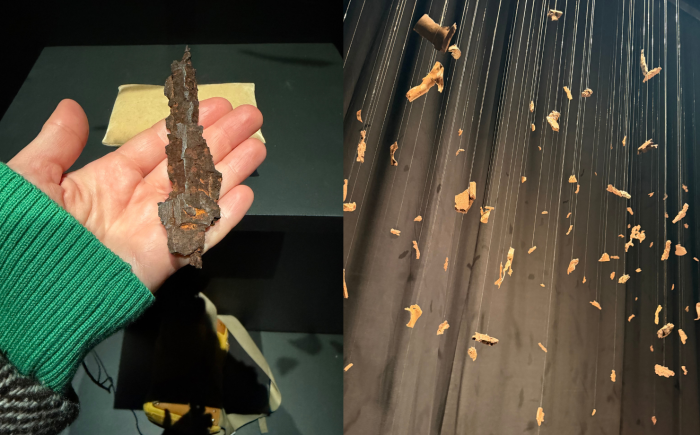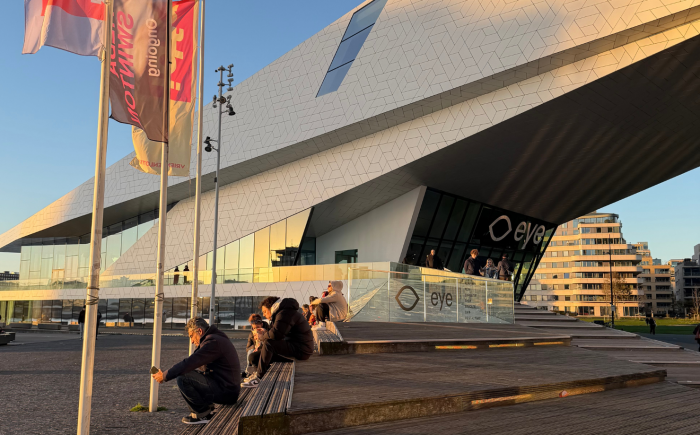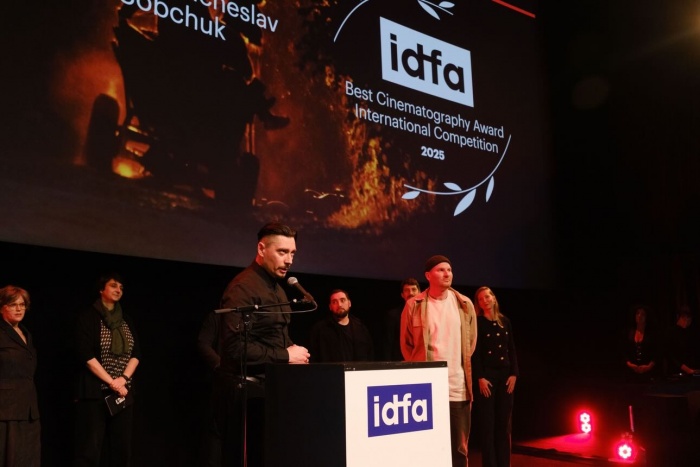Member of the Selection Council and Director of the Communication Department of NGO "Docudays", Darya Averchenko, travelled to one of the world’s largest documentary film festivals, IDFA in Amsterdam. Read the author’s observations and reflections on this year’s program, the topics circulating within the film community, and discoveries for Docudays UA 2026.
I’ve been studying the opening ceremonies of festivals for a long time. Usually, all the busy industry people arrive a day later, but I never do. For 17 years now, I’ve been writing the opening scripts for Docudays UA, so I always take a peek into my colleagues’ kitchen.
This time I arrived at the 38th IDFA on November 13 – to see the renewed festival, as this year, after the end of the second Orwa Nyrabia’s term, it was headed by Isabel Arrate Fernandez.
For many years, the festival has opened at the Carre Theatre, carpeted in red and adorned with gilded chandeliers. Yet the ceremony itself was rather restrained, without hosts or music. The head of the festival appeared on stage immediately, speaking about her Chilean roots and the fate of her emigrant family, who, having lost the struggle against Pinochet’s regime, found themselves in Rome, then moved to Berlin, and finally settled in Amsterdam. Isabel’s father planned to return to Chile every year, but it never happened. The opening felt like a personal conversation, in which the new director gradually led the audience into the screening of three challenging short films: Shaimaa Awad’s Crossing Memory, Mohammadreza Farzad and Pegah Ahangarani’s As I Lay Dying, and Fırat Yücel’s happiness.
The Palestinian film Crossing Memory portrayed everyday life in Gaza. In every third shot, children killed in shelling were being buried; in every other, local teenagers were tracking groups of Israeli soldiers to throw stones at them.
The second film followed classmates caught in the turmoil of the Green Revolution in Tehran. Some joined the protests and ended up behind bars, some tried to emigrate unsuccessfully, some chose to hide and wait it out, finding work in a bar, and some died young on the streets of the capital from police bullets.
The last film was shot in the Netherlands and told of sleepless nights caused by terrifying news from around the world and the pro-Palestinian demonstrations in Amsterdam, which the filmmaker attends diligently.
On the one hand, the opening had a political stance – unlike, say, DOK Leipzig, which has for years avoided global crises. On the other hand, the Dutch documentarian sitting to my right quietly said:
“I understand that there are many wars in the world, but the most threatening one for us is Russia’s war against Ukraine. Why wasn’t it mentioned from the stage?”
It was raining outside. On the way back to the hotel, I noticed several Ukrainian flags hanging on unfamiliar balconies – sometimes next to Palestinian ones.
The very next day, Ukrainian filmmakers began arriving in Amsterdam.
I already knew about the participation of Dmytro Sukholytkyy-Sobchuk’s Silent Flood in the main competition, but I was genuinely delighted to see the presence of Liza Smith, Alina Gorlova, and Simon Mozghovyi’s Militantropos, Mstyslav Chernov’s 2000 Meters to Andriivka, and Kateryna Gornostai’s Timestamp in Best of Fests.
Director Kateryna Gornostai and the editor of Timestamp, Nikon Romanchenko, at the IDFA festival. Photo: Darya Averchenko
In the industry program of presentations running parallel to the Forum, two projects from Ukrainian colleagues were also featured. I must say that within the showcase, the projects Meet It Without Fear by Svitlana Lishchynska (producers: Svitlana Lishchynska and Fredrik Lange) and Everything’s Fucked Up by Hanna Yaroshevych (producers: Kateryna Ptashka and Oleksandra Bratyshchenko) looked a head above the projects of foreign colleagues from Hungary, Slovakia, and Sakartvelo.
The next day, I headed to the Forum. And it became obvious: projects that make it into the largest European pitching event are the result of years of research, personal stories, and meticulously crafted dramaturgy.
In the corridors, I learned that the Forum offers a paid pitch training option. And you can instantly recognize the pitches that passed expert selection: perfect, confident, sharply crafted, a pleasure to watch.
Skipping ahead, I’ll say that the Forum was won by a project about a queer woman from a Chinese province. One day she came out and told her family everything. Her grandmother didn’t hesitate and proposed a plan – and even a schedule — for… driving out the demons. The incredibly warm yet sharply dramatic trailer depicted the methods used to chase the demons away: from elaborate rituals involving a shaman to simply spanking her with a tennis racket.
And although the presentation and trailer were truly promising, I caught myself thinking that maybe the Forum’s prize is the industry’s way of turning away from politics for a moment and looking into “smaller” worlds where there are no wars?
This year, DocLab –which I always visit at IDFA – was also rather apolitical. Its theme focused on human–internet relations, gadget influence, screen time, and AI. The topic isn’t new, and only occasionally something truly witty surfaced – for example, a lesbian identity simulator offering you to try on a new self with all the prejudices of society and family attached.
But reading letters addressed to “the Internet,” which supposedly saves one from loneliness or, on the contrary, teaches laziness, was dull. What a luxury, to ponder such a chewed-over topic, and at IDFA of all places.
DocLab's Installation In 36,000 Directions by artist from Tunis Tarin Ben Houlifa. Photo: Darya Averchenko
The only truly important installation in the cross-media section, in my view, was In 36,000 Directions by Tunisian artist Tarin Ben Houlifa. Visitors were invited into a room where a piece of iron shrapnel lay on a cushion, and headphones hung to the left. As soon as you put on the headphones and picked up the fragment, the room lit up, revealing thousands of tiny metal shards suspended in the air. The voice in the headphones explained that the iron pieces were collected by the artist on the front line in Ukraine and that this is what a shell looks like as it explodes, flying in 36,000 directions and bringing deadly danger to humans and animals. Even for visitors from Ukraine, it was a powerful experience. From the news, I could never imagine how heavy and terrifying these fragments were. After holding one in my hands, I walked away feeling crushed, imagining the front line and life in frontline towns.
But the most important thing at IDFA is the international film premieres. I tried to catch the main competition screenings on the big screen, paying attention to full auditoriums and the audience’s response. It is genuinely pleasing that the festival draws full houses, that strong interest in documentary cinema remains – nowhere else does this trendiness and demand feel so palpable.
EYE Filmmuseum. Photo: Darya Averchenko
Of course, I awaited the premiere of Silent Flood by Dmytro Sukholytkyy-Sobchuk most of all. We met with the director at the EYE Filmmuseum, one of the festival’s most beautiful venues. Dmitry recalled that ten years had passed since the premiere of Ukrainian Sheriffs, and no Ukrainian film had made it into the main competition since then. We joked that if you’ve made it in, you should win a prize.
After watching it, I was absolutely convinced of that.
It is a film-parable: beautiful and slow. Fog, a crossing over the Dniester high in the Carpathian Mountains. In the frame are adults and children waiting on the riverbank for a cable pontoon. Villagers’ voices recount a silent flood that happened here in the last century, but the memory of it – and the fear – still lives on.
We are transported to a settlement of a religious community known locally as “the cap-wearers,” after the shape of their headgear. They live quietly, in a closed settlement, without using modern conveniences: they wash clothes in the river, scrubbing them against stones, grow their own wheat, grind flour, and bake bread in an oven. They go to bed at sunset. They rise early and go straight to work. Their religion forbids the men of the commune to fight; girls, after ninth grade, prepare for marriage. It seems like a small, tranquil world of harmonious coexistence with nature and people – in the cap-wearers’ understanding.
But smoke rises above the fields. A car in the dusk, lit by headlights, gathers food for the front: bread fresh from the oven is wrapped in plastic.
We are in another part of the country. Soldiers have gathered in a house for Christmas dinner. They gratefully eat the homemade dishes sent for their festive table and speak wistfully of home. The silent flood – the dangerous, creeping force of war, sometimes invisible to those far from the front – inevitably moves toward the shore.
The team of the film Silent Flood during the award ceremony for Best Cinematography. Photo: IDFA
Congratulating the team on the premiere, we agreed that the first screening in Ukraine would take place at Docudays UA in June. This film must be seen on big screens, especially as last Friday the jury awarded it Best Cinematography. We join in congratulating all four cinematographers of Silent Flood: Ivan Morarash, Oleksandr Korotun, Viacheslav Tsvietkov, and Dmytro Sukholytkyy-Sobchuk! May we have to wait no more than a year for the next Ukrainian film in the international competition – right up to IDFA’s 39th edition.
For participation in IDFA within the “Ukrainian Delegation,” the author thanks the Ukrainian Institute, the Netherlands Film Fund, and Docudays UA.
Main photo: Award ceremony. Photo: from the IDFA website.